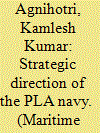| Srl | Item |
| 1 |
ID:
143766


|
|
|
|
|
| Summary/Abstract |
In the autumn of 1962, two weeks before U-2 aerial photographs confirmed Soviet deployments of nuclear missiles in Cuba, the US intelligence community attempted to image the island with the spy satellite Corona. Insufficient image resolution and extensive cloud cover, however, prevented this photography from providing solid evidence confirming or denying the presence of offensive missiles. This event – previously unaddressed either by Missile Crisis or Corona scholars – illustrates both the promise and the limits of early satellite imagery intelligence. It further provides insight into the early imagery tasking and coordination process and demonstrates needs that drove further development of national satellite reconnaissance in the years that followed.
|
|
|
|
|
|
|
|
|
|
|
|
|
|
|
|
| 2 |
ID:
084283


|
|
|
| 3 |
ID:
100295


|
|
|
|
|
| Publication |
2010.
|
| Summary/Abstract |
Taking as its premise the conceptualisation of the Internet as a virtual public space, this article focuses on the manner in which language play is manifested through the manipulation of linguistic (and particularly orthographic) conventions in informal Computer Mediated Communication (CMC) and in cell phone emails in Japan. The flexibility of the Japanese writing system, with its three official scripts often also combined with Arabic numerals and the Roman alphabet, lends itself very well to ludic use of orthography to create a desired effect. Users therefore play with standard orthographic conventions in cyberspace to an extent not possible for single alphabet users, subverting norms in order to create eye-catching effects which strengthen in-group solidarity through play and in some cases act as markers of subcultural identities. From time to time it is suggested that innovative use of orthography in cyberspace is a product of new electronic technologies. I argue, however, that language play of this kind, far from being new to Japan, builds on an already existing tradition of orthographic creativity facilitated by the nature of the writing system, the only real difference being that the practice has now moved into the much wider public arena of cyberspace.
|
|
|
|
|
|
|
|
|
|
|
|
|
|
|
|
| 4 |
ID:
097648


|
|
|